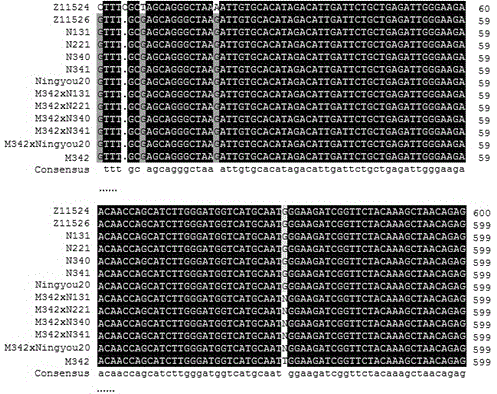Primers for detecting anti-sulfonylurea herbicide gene BnALS3R of cabbage type rape and application of primer
A Brassica napus, sulfonylurea-resistant technology, applied in application, plant genetic improvement, DNA/RNA fragment, etc., can solve the problems of improper use of herbicides, spraying, unevenness, etc., and achieves easy operation, accurate and reliable results. , the effect that is easy to judge
- Summary
- Abstract
- Description
- Claims
- Application Information
AI Technical Summary
Problems solved by technology
Method used
Image
Examples
Embodiment 1
[0044] Example 1 The development process of the BnALS3R molecular marker for the detection of sulfonylurea herbicide resistance gene in Brassica napus
[0045] (1) Development of AS-PCR molecular markers for detection of rapeseed sulfonylurea herbicide resistance gene BnALS3R
[0046] The sulfonylurea herbicide resistance gene BnALS3R of Brassica napus was cloned from the mutant M342 induced by EMS (see Pu Huiming et al., patent application number 201310054645.9). Compared with the acetolactate synthase III gene of wild-type N131, the mutant BnALS3 gene had a single-base mutation, that is, +1667 guanine nucleotides (G) downstream of the first nucleotide of the start codon Mutated into a thymine nucleotide (T) (Hu Maolong et al., ZL201310111739.5, a sulfonylurea herbicide resistance gene and its application in Brassica napus), and related genes can be developed based on the single base variation of this site Molecular marker detection resistance gene BnALS3R.
[0047] First, ...
Embodiment 2
[0073] Example 2 Detection and Identification of Molecular Marker BsrDI-ALS3R in Segregation Populations Against Resistance Gene BnALS3R Genotype
[0074] In order to verify the detection effect of molecular marker BsrDI-ALS3R on BnALS3R genotypes resistant to sulfonylurea herbicides in Brassica napus, we tested it in three types of BnALS3R genotype isolates. The F2 population was obtained by selfing the F1 of the MICMS double-low restorer line N221 and M342; the BC1 population was obtained by backcrossing the F1 of the N221 and M342 cross with N221; The herbicide Rapeseed M342 was obtained by backcrossing. The leaves of the rapeseed plants were taken at the seedling stage, and the genome DNA was extracted for PCR amplification. DNA extraction, PCR reaction, enzyme digestion reaction, and electrophoresis detection methods are the same as above. The test results showed that there were three genotype plants in the F2 population ( image 3 ), that is, a homozygous resistant si...
Embodiment 3
[0075] Example 3 Breeding herbicide-resistant MICMS restorer lines using molecular marker-assisted selection
[0076] Breeding herbicide-resistant hybrid rapeseed can solve the current problem of chemical weed control of dicotyledonous weeds in rapeseed fields, saving labor and cost, and the herbicide-resistant trait can also be used as a marker trait in hybrid rapeseed production, provided that the resistant The herbicide traits were imported into the MICMS restorer lines. The MICMS restorer line resistant to sulfonylurea herbicides can be rapidly bred through the marker-assisted selection technique using the molecular marker BsrDI-ALS3R of the present invention. We tested the resistance genes of the plants in the F2 population obtained by selfing of three kinds of F1 (N221×M342, N340×M342 and N341×M342), and bagged the fertile individual plants with a molecular weight band of 766bp. F3 seeds containing homozygous sulfonylurea herbicide resistance gene BnALS3R were obtained....
PUM
 Login to View More
Login to View More Abstract
Description
Claims
Application Information
 Login to View More
Login to View More - R&D
- Intellectual Property
- Life Sciences
- Materials
- Tech Scout
- Unparalleled Data Quality
- Higher Quality Content
- 60% Fewer Hallucinations
Browse by: Latest US Patents, China's latest patents, Technical Efficacy Thesaurus, Application Domain, Technology Topic, Popular Technical Reports.
© 2025 PatSnap. All rights reserved.Legal|Privacy policy|Modern Slavery Act Transparency Statement|Sitemap|About US| Contact US: help@patsnap.com



